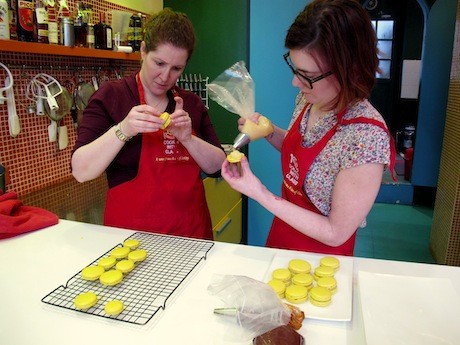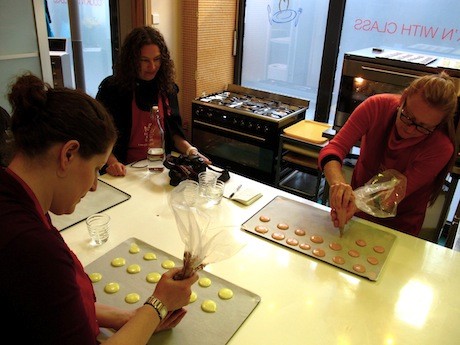Hands-On French Pastries: Macaron Classes at Cook’n with Class

Mon 6 May 2013

I’m known among my friends as an exacting and judgmental connoisseur of macarons, those famous French pastries. I’ve tried nearly every macaron shop in Paris and have a long list of criteria for what constitutes the perfect mac, but it essentially boils down to whether those three sweet bites make me feel joyous to be alive. So when I learned that Cook’n with Class offers a macaron-making class in Montmartre, I knew I had to try it out. After all, how could I be a truly fair judge if I didn’t know how the little delights were created? Also, I would probably get to take some home with me.
As it turns out, the tiny suckers are a finicky little treat. My mom always reminds me that “cooking is improvisation, but baking is chemistry,” and indeed, these purely Paris pastries are shockingly easy to mess up. I found that the process is like a sugary obstacle course, little traps of specificity waiting at every turn to ruin your hard-earned treats. “Every step must be followed to the letter,” our instructor, pastry chef Briony Laberthonnière, warned us at the beginning. “Once they are made and ruined, it’s very difficult to figure out what went wrong.” But no pressure. There were four of us ladies in the English-taught class, and two of them were chemical engineers, so I knew they would be fine. But what about ladies like me, whose culinary philosophy is “put together everything you like, and if it doesn’t taste right, add more?”

The author (right) and a fellow student making macarons at Cook’n with Class.
Luckily the class did not afford much opportunity for me to mess things up too badly. Our creation of 60 macarons in three flavors (chocolate-coffee ganache, piña colada, and caramel au beurre salé) was a group effort, a three-hour process during which we watched, talked with and learned from Laberthonnière, helping out and getting our hands dirty in every step of the process with her, from stirring ingredients to feel the correct texture of the ganache, to piping in order to practice laying the shells for baking, to filling and assembling the macs themselves. Laberthonnière deftly guided us through the process, making it look not like the impossible task I’d imagined, but like a delicious challenge that, with practice, could make master pâtissières of us all.
As sweet smells wafted through the cozy kitchen, we learned how to make not just macarons, but salted caramel, and chocolate-coffee ganache, and fruit marmalade, and even Italian meringue (the adhesive base for the almond meal–based shells). We learned and perfected the proper macaronage, a whipping technique in which you beat the air out of the shell mix. It starts off in the bowl as a grainy, gooey mixture and, after being beat into submission, transforms as if by magic into a shiny, wet mix with a ribbon-like texture, prime for piping.

Laberthonnière offered us dozens of tips and tricks on how to complete each step, including why the European method of weighing ingredients is better than using cups and tablespoons (it’s more precise, a key component of mac-making), the order of adding ingredients (water before sugar), right down to what kind of bowls to use (glass or metal is best, as ceramic is too porous and plastic holds too much fat to its sides, which can ruin your pastry balance). The theme of the day, a mantra that I might just incorporate into my everyday life, seemed to be “little by little.” Temper the egg whites, heating them drop by drop. Pour the cream over the chocolate slowly, and whisk it gently to attain the perfect texture. Fold the meringue gently into the gently sifted almond-sugar mix. When making one of the most delicate and finicky pastries in the world, easy does it.
If you rush through the process, you could end up with lumpy salted caramel, or deflated, oily shells, or, God forbid, scrambled-egg macarons. The precision and perfect timing required for making macarons astounded me. The humidity of the oven has to be perfect, and the oven has to be ideally vented. The egg whites have to be at room temperature when you begin, and strained. If heating the milk mixture required for the ganache causes some of it to evaporate, you must add more to even out those last few milliliters. And heaven help you if you use cream that’s too cold or add your syrup to your whipped egg whites too late.

Yet at the end, having completed our five dozen macarons, I looked at our finished work and was amazed by a feeling of success. I ate one, then another, then another (I had to try each flavor, after all!), and couldn’t believe I had helped create these beautiful, delicious little desserts. They were amazing, and 100 percent on a par with my high mac standards.
That night, Laberthonnière sent the four of us detailed recipes (and even a troubleshooting guide) for our macarons and all three fillings, assuring us we could always e-mail her for advice. Even though I had actually already experienced the creation of these recipes, they were pretty intimidating to look over, and I realized where three whole hours of a rainy afternoon had gone. I now have a whole new respect for the Ladurées and the Pierre Hermés of the world. Because a macaron is, in fact, like a woman herself: at times temperamental and sensitive, but when you get the balance right, she will reward you with waves of happiness.
Editor’s note: Did you know we have several foodie walking trips, including a wine walk? Download one today.